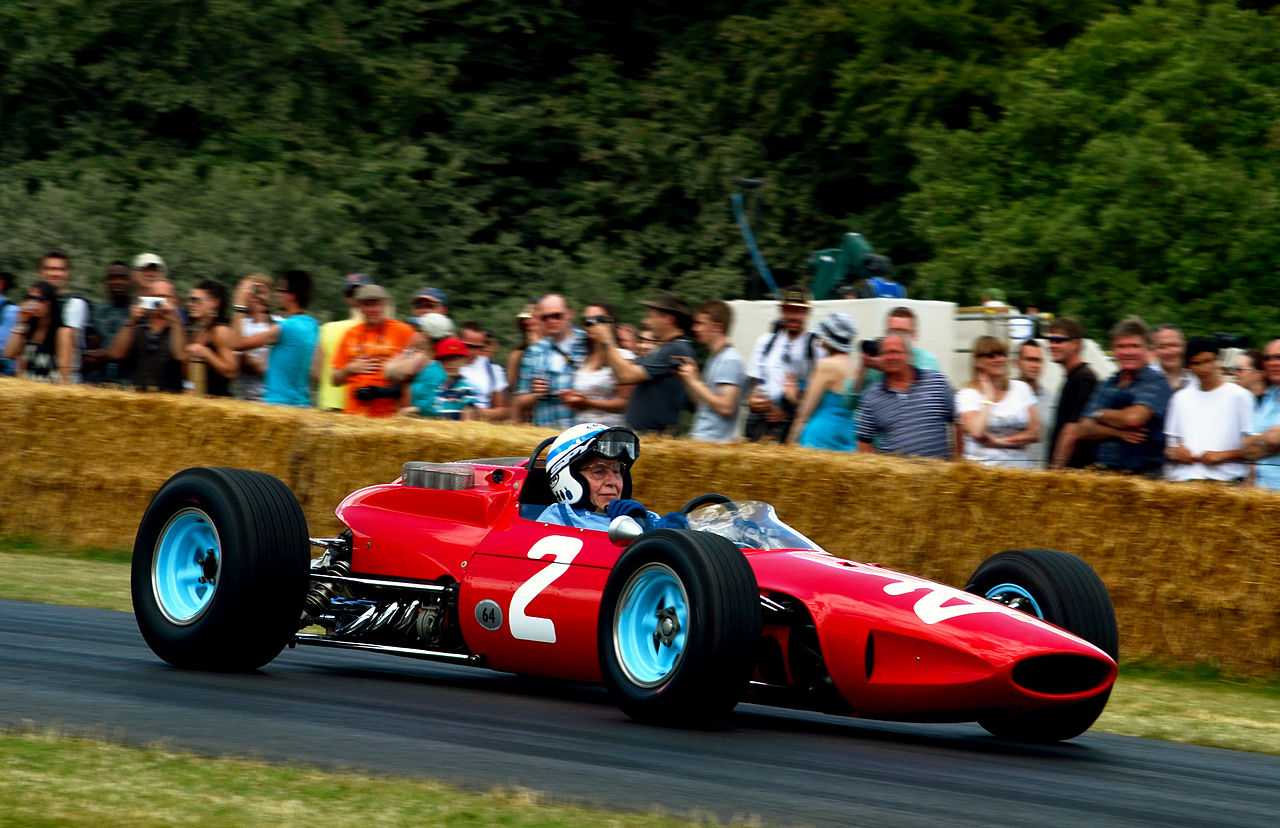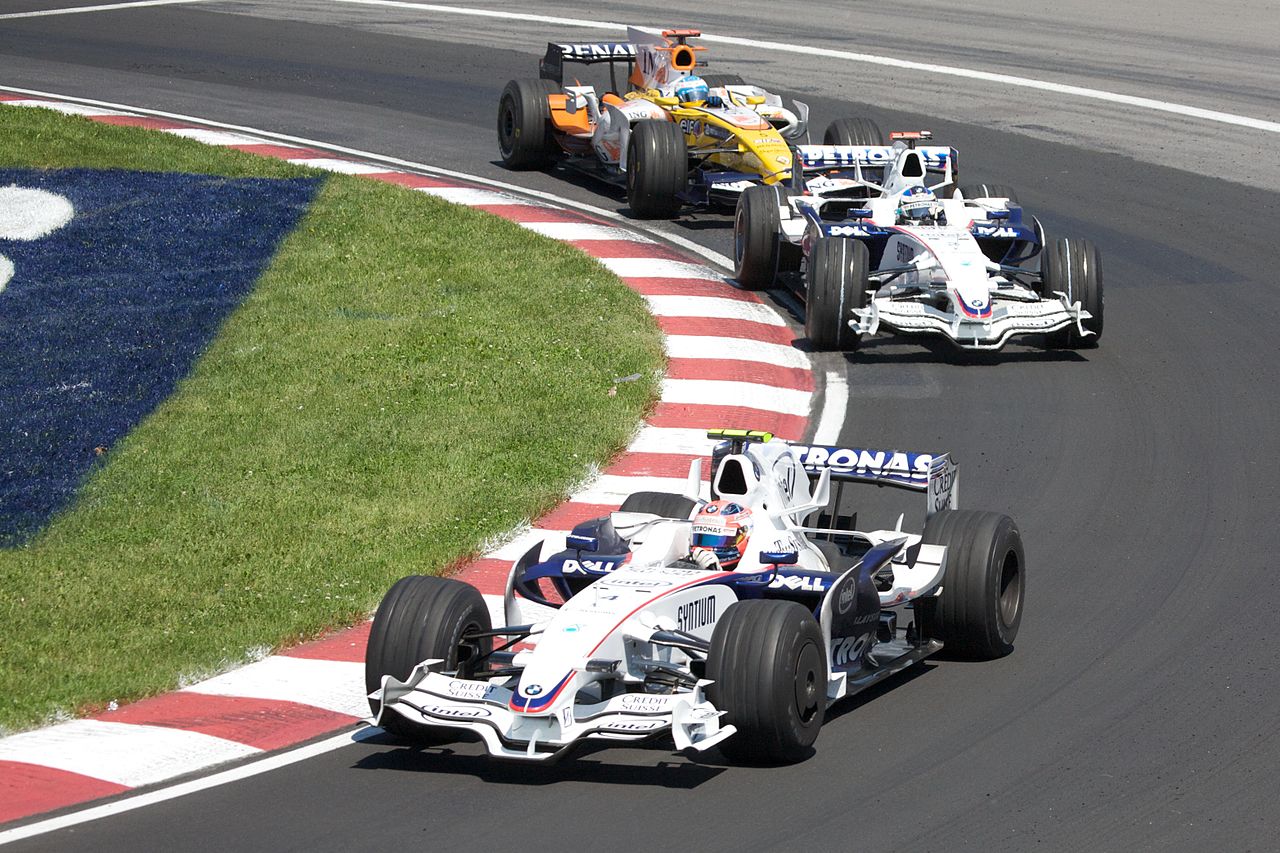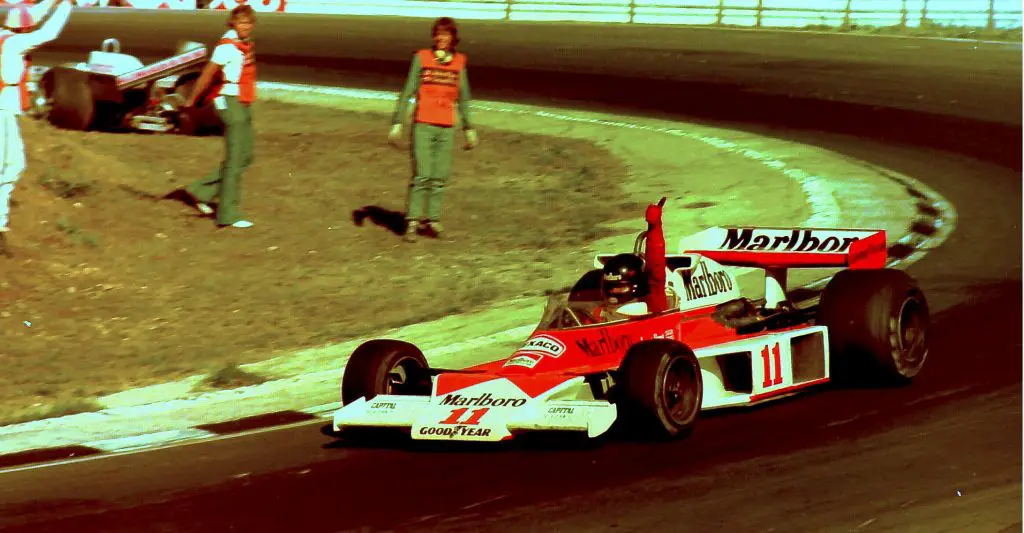Since the F1 Drivers’ Championship began at Silverstone in 1950, 61 different drivers have led the title hunt. That list features nine drivers who led after only one round of the championship – including two World Champions. We take a look at the drivers who led the F1 title race only once.
1958 Monaco Grand Prix: Luigi Musso
Luigi Musso won only one race in his Formula 1 career – the 1956 Argentine Grand Prix, where he shared a drive with Juan Manuel Fangio – but went on to lead the Drivers’ Championship two years later. The Ferrari driver finished as runner-up to Stirling Moss in the season-opening 1958 Argentine Grand Prix and finished as runner-up to Maurice Trintignant at the Monaco Grand Prix.
With Trintignant having not raced in Argentina and Moss retiring in Monaco, Musso took the championship lead by four points. Moss would then re-take the lead following the next round of the season at Zandvoort. Musso would never lead the championship again and was killed just a few races later when chasing down eventual 1958 champion Mike Hawthorn in the French Grand Prix.

1964 Mexican Grand Prix: John Surtees
John Surtees led the Drivers’ Championship only once in his career, right at the end of the 1964 season. His championship victory made him the first – and only – man to win world titles on both two and four wheels. Surtees had not led the title race all year, and was five points behind Graham Hill heading into the final round.
Hill, Surtees and Jim Clark were all still in contention for the title at the Mexican Grand Prix. Surtees finished second, with Clark fifth and Hill out of the points. The result meant Surtees won the championship by a single point and, despite continuing to race in Formula 1 until 1972, he never led the Drivers’ Championship again.
1966 Belgian Grand Prix: Lorenzo Bandini
With a pair of podium finishes in the first two races of the 1966 season, Lorenzo Bandini took the title lead from Jackie Stewart at the conclusion of the Belgian Grand Prix. He sat one point ahead of both Stewart and John Surtees. It would be eventual 1966 World Champion Jack Brabham who usurped Bandini as title leader.
At the very next race in France, Brabham won and Bandini finished 11 laps down. The Australian took a two point lead and no one would truly challenge him for the rest of the year. Bandini ultimately finished eighth in the Drivers’ Championship and never led the title race again. He was killed the following year in a crash at the Monaco Grand Prix.
1967 South African Grand Prix: Pedro Rodriguez
The first South African Grand Prix to be held at the Kyalami circuit took place in 1967 and was won by Mexican driver Pedro Rodriguez. His win at the first race of the season saw him get his year off to the best possible start, and he led by three points from South African driver John Love, who had finished as runner-up in his home event.
This was Rodriguez’s first of two F1 victories. He would finish fifth at the next race in Monaco, but Denny Hulme – who had finished fourth in South Africa – won the race, and took the title lead by a single point. Rodriguez remained Hulme’s closest championship challenger until the French Grand Prix, but he ultimately finished sixth that year and would not be a title contender again.
1976 Japanese Grand Prix: James Hunt
James Hunt led the Drivers’ Championship only once in his career, but it was when it mattered – at the conclusion of the 1976 season finale. In a politically charged season – and a season in which one of the main protagonists was nearly fatally injured – Hunt won the title by finishing a single point ahead of rival Niki Lauda. Lauda held the lead comfortably until the German Grand Prix, when a fiery crash put him out of action for two races.
The Austrian courageously returned at the Italian Grand Prix, by which point Hunt had closed down Lauda’s lead to just two points. Lauda remained fractionally ahead until the final race of the year, at Fuji Speedway, where he withdrew from the race after two laps due to the dangerous wet conditions. That allowed Hunt, who finished third, to score enough points to clinch the title at the final round of the season. The British driver raced in F1 for a further three seasons, but would not lead the championship hunt again.

1978 Monaco Grand Prix: Patrick Depailler
When Patrick Depailler won the 1978 Monaco Grand Prix he rose to the top of the championship standings, five points ahead of both Carlos Reutemann and Mario Andretti. This was the first of two wins in Depailler’s career, the other being at the 1979 Spanish Grand Prix. After Monaco came Spa, where the Frenchman retired as his Tyrrell hit gearbox troubles. With Andretti taking the victory, the American moved back ahead of Depailler in the title hunt. Depailler never topped the standings again in his career and was killed less than two years later in a private test session at the Nurburgring.
2005 Australian Grand Prix: Giancarlo Fisichella
Renault proved to be a real title threat to Ferrari in 2005, following the Scuderia’s domination of the sport in the early 2000s. It was Giancarlo Fisichella who supplied the Enstone-based team with their first victory of 2005, taking the win at the season-opening 2005 Australian Grand Prix. The Italian led the title race as a result. This would prove to be Fisichella’s only win of the season and, with team-mate Fernando Alonso winning the next round in Malaysia, Fisichella dropped down the order in the standings. He would never lead the Drivers’ Championship again in his career.
2008 Canadian Grand Prix: Robert Kubica
Robert Kubica scored the only win of his Formula 1 career at the 2008 Canadian Grand Prix and, as a result of his win, took the lead in the Drivers’ Championship for the only time in his career. His lead would be short-lived however, as Felipe Massa won at the next round in France and moved ahead of Kubica in the standings.
The other drivers who led the F1 title race only once
While the above list of drivers led the title race after only one round of the championship, there are a further 14 drivers who have led the title race only once in their career, but their lead lasted for more than one race. These drivers are listed below:
Piero Taruffi, 3 races
After winning the season opening 1952 Swiss Grand Prix and picking up an additional point for setting the fastest lap, Ferrari’s Pierro Taruffi led the early stages of that year’s championship. He maintained a one point lead despite not entering the next round – the Indianapolis 500 – and then continued to lead after the third round – albeit in a tie with Alberto Ascari – despite retiring from the race.
Alberto Ascari, 14 races
Alberto Ascari won two World Championships, in 1952 and 1953, yet only led the title race for a single 14 race streak. The Italian seized the championship lead from Pierro Taruffi as a result of winning the 1952 French Grand Prix. He then maintained that lead until the end of the following season, during which time he won an impressive 11 races; including seven consecutively.
Maurice Trintignant, 2 races
Maurice Trintignant led the Drivers’ Championship for two races as a result of winning the 1955 Monaco Grand Prix. His victory allowed him to eke out a 1.33 point lead over Juan Manuel Fangio, who retired from the race. With no regular F1 drivers competing at the next round – the Indianapolis 500 – Trintignant’s lead remained stable. Fangio was back on form at the Belgian Grand Prix while Trintignant failed to score in sixth place. The Argentine resumed the lead of the title race and Trintignant would fail to top the standings again.
Jean Behra, 3 races
Strangely, Jean Behra led the Drivers’ Championship after the opening race of the 1956 season despite not winning the race. The 1956 Argentine Grand Prix was won by Luigi Musso and Juan Manuel Fangio, who shared a drive at Ferrari. As a result, the 9 points awarded were split between the two drivers, with Musso picking up four points and Fangio awarded five points – including an additional point for recording the fastest lap. As a result of this, Behra – who finished second – scored more points than the leading duo.
A third place in the Monaco Grand Prix – again with Fangio finishing one place above in another shared drive – allowed the Frenchman to retain his title lead. Behra would continue to lead after the third round, the Indianapolis 500, but both Stirling Moss and Peter Collins pulled a point clear as a result of the Belgian Grand Prix.
Peter Collins, 3 races
For the three races immediately after Behra had led the 1956 title hunt, Peter Collins would lead for a streak of three races. After winning the Belgian Grand Prix he tied with Stirling Moss at the top of the standings, with the former deemed to be the championship leader. Collins followed up his Belgian performance with another win in France, pulling further into the lead.
Juan Manuel Fangio won in Britain while Collins retired, but the Brit maintained his lead by a single point. The same result followed three weeks later at the German Grand Prix and as a result Collins lost the title lead and would never lead again in his career.
Mike Hawthorn, 5 races
A string of podium results over the summer of 1958 – including a win at the French Grand Prix – left Mike Hawthorn in the championship lead. It was a lead that he would not lose, and he would go on to win the championship by a single point. Hawthorn would not drive in F1 again after this, as he was killed in a road traffic accident before the start of the 1959 season.
Wolfgang von Trips, 2 races
Wolfgang von Trips seized the lead of the 1961 Drivers’ Championship after winning the British Grand Prix at Aintree. Having continued to lead with a second place finish at the German Grand Prix, von Trips headed to the Italian Grand Prix with a four point advantage over Phil Hill – the only man who could still prevent him from winning the title.
But the 1961 Italian Grand Prix would end in tragedy, with von Trips crashing out on the first lap in an accident that would claim his and numerous spectators’ lives. Hill went on to win the race and with it won the 1961 title.
Jochen Rindt, 8 races
Jochen Rindt is Formula 1’s only posthumous champion. The Austrian took the lead in the title race from Jackie Stewart as a result of winning the 1970 French Grand Prix. Rindt kept hold of the lead and, despite his death in qualifying for the Italian Grand Prix, his points tally was unbeaten for the last three races of the year. This eight race stint at the top of the standings was the only time he led the championship in his career.
Gilles Villeneuve, 2 races
It did not take long after his arrival into Formula 1 for Gilles Villeneuve to become a motorsport superstar. The Canadian assumed the title lead in only his second full season in the sport. He did so at the conclusion of the United States Grand Prix West, where he took a second consecutive win, having also won the previous round in South Africa.
However, Villeneuve was to have a run of poor form over the next three races and scored no points. He lost the lead after the Belgian Grand Prix, where Jacques Laffite climbed atop the standings. Despite his superstar quality, Villeneuve never led the Drivers’ Championship again.
Rene Arnoux, 3 races
In Rene Arnoux’s 12 seasons in Formula 1, he led the championship for a single streak of three races. Arnoux sailed to the top of the standings after the third round of the 1980 season. The Frenchman took his first Grand Prix victory at the Brazilian Grand Prix and followed it up with another win at the third round in South Africa.
The Renault driver failed to score next time out at Long Beach, but his two wins allowed him to maintain the championship lead – despite being tied on points with Nelson Piquet. He extended his lead to two points as a result of the Belgian Grand Prix but retirement in Monaco brought his single spell at the top of the standings to an end.
John Watson, 3 races
Alain Prost led the first six rounds of the 1982 championship. In a year where there were four title leaders, three of those would lead the title only once in their respective careers. The first of those three was John Watson, who assumed the title lead as a result of winning the 1982 Dallas Grand Prix from 17th on the grid.
A third place in Canada saw Watson extend the lead to ten points, but a ninth place at Zandvoort left him with only a one point advantage. He retired from the next race at Brands Hatch, and lost the lead in the championship.
Didier Pironi, 4 races
Taking Watson’s lead was Didier Pironi. While Watson faltered, Pironi won at Zandvoort and took a second place finish at Brands Hatch. Now in the lead of the championship, the Frenchman extended that lead from five points to nine with a third place result at his home Grand Prix in France.
However, this would be Pironi’s final finish, as he would suffer a career-ending crash in qualifying for the next round in Germany. Pironi had already set a time good enough for pole before his crash, and his title lead would remain at nine points following the race’s conclusion. He would continue to lead the title race until the Swiss Grand Prix.
Keke Rosberg, 3 races
With Pironi inactive, Keke Rosberg seized the lead of the 1982 World Championship after winning the Swiss Grand Prix. That win was the only one of the season for Rosberg in what would be a title-winning year for the Finnish driver. Rosberg would win the title by five points (ahead of Pironi) but would never lead a championship charge again in his career.
Elio de Angelis, 2 races
Elio de Angelis took the lead of the 1985 Drivers’ Championship from Michele Alboreto following the third round of the season at Imola. De Angelis won the San Marino Grand Prix in what would be the final win of his career. He picked up a further four points with a podium finish at the Monaco Grand Prix, but a fifth place finish at the Canadian Grand Prix, while Alboreto won, saw the Italian re-take the title lead. De Angelis would be killed less than a year later in a testing crash and would not lead the championship again.
Charles Leclerc, 5 races
Charles Leclerc led the title race after the first five races of the 2022 season. Winning the season-opening Bahrain Grand Prix, Leclerc’s lead went as high as 34 points after another victory at the Australian Grand Prix. However, he was soon reeled in by Max Verstappen, who took the championship lead as a result of the Spanish Grand Prix. Leclerc is yet to lead the Drivers’ Championship again.
Header image: Martin Lee, Flickr / CC BY-SA 2.0
This article was originally published in June 2020 and has since been updated.


Pingback: F1 Drivers Who Led the Championship the Most Times - Lights Out ●●●●●